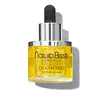What's inside
What's inside
 Key Ingredients
Key Ingredients

 Benefits
Benefits

 Concerns
Concerns

No concerns
 Ingredients Side-by-side
Ingredients Side-by-side

Ethylhexyl Stearate
EmollientCetearyl Ethylhexanoate
EmollientPPG-3 Myristyl Ether
EmollientPunica Granatum Seed Oil
EmollientCalendula Officinalis Flower Extract
MaskingSalicyloyl Phytosphingosine
Skin ConditioningSalvia Hispanica Seed Oil
MoisturisingAmaranthus Caudatus Seed Extract
Skin ConditioningAlaria Esculenta Extract
Skin ProtectingTocopheryl Acetate
AntioxidantHelianthus Annuus Seed Oil
EmollientGlyceryl Linoleate
EmollientGlyceryl Linolenate
EmollientDaucus Carota Sativa Seed Oil
EmollientDaucus Carota Sativa Root Extract
Skin ConditioningBeta-Carotene
Skin ConditioningTocopherol
AntioxidantRosmarinus Officinalis Leaf Extract
AntimicrobialCaprylic/Capric Triglyceride
MaskingOctadecyl Di-T-Butyl-4-Hydroxyhydrocinnamate
AntioxidantBenzotriazolyl Dodecyl P-Cresol
UV AbsorberDilauryl Thiodipropionate
AntioxidantParfum
MaskingLinalool
PerfumingCoumarin
PerfumingAmyl Cinnamal
PerfumingLimonene
PerfumingEthylhexyl Stearate, Cetearyl Ethylhexanoate, PPG-3 Myristyl Ether, Punica Granatum Seed Oil, Calendula Officinalis Flower Extract, Salicyloyl Phytosphingosine, Salvia Hispanica Seed Oil, Amaranthus Caudatus Seed Extract, Alaria Esculenta Extract, Tocopheryl Acetate, Helianthus Annuus Seed Oil, Glyceryl Linoleate, Glyceryl Linolenate, Daucus Carota Sativa Seed Oil, Daucus Carota Sativa Root Extract, Beta-Carotene, Tocopherol, Rosmarinus Officinalis Leaf Extract, Caprylic/Capric Triglyceride, Octadecyl Di-T-Butyl-4-Hydroxyhydrocinnamate, Benzotriazolyl Dodecyl P-Cresol, Dilauryl Thiodipropionate, Parfum, Linalool, Coumarin, Amyl Cinnamal, Limonene
Vitis Vinifera Seed Oil
EmollientOrbignya Oleifera Seed Oil
EmollientSimmondsia Chinensis Seed Oil
EmollientArgania Spinosa Kernel Oil
EmollientCorylus Avellana Seed Oil
EmollientHelianthus Annuus Seed Oil
EmollientVaccinium Macrocarpon Seed Oil
Skin ConditioningHippophae Rhamnoides Fruit Extract
Skin ConditioningPunica Granatum Seed Extract
Skin ConditioningPongamia Glabra Seed Oil
Skin ConditioningTocopheryl Acetate
AntioxidantBisabolol
MaskingAesculus Hippocastanum Seed Extract
Skin ConditioningGlycyrrhiza Glabra Root Extract
BleachingChamomilla Recutita Flower Extract
MaskingDaucus Carota Sativa Root Extract
Skin ConditioningLecithin
EmollientGlycerin
HumectantWater
Skin ConditioningHydrolyzed Rice Protein
Skin ConditioningLithothamnion Calcareum Extract
Skin ConditioningPentylene Glycol
Skin ConditioningRosmarinus Officinalis Leaf Extract
AntimicrobialAlanyl Glutamine
HumectantArginine
MaskingBetula Alba Oil
MaskingOligopeptide-177
Oligopeptide-6
Skin ConditioningPotassium Sorbate
PreservativeSodium Hydroxide
BufferingTocopherol
AntioxidantVitis Vinifera Seed Oil, Orbignya Oleifera Seed Oil, Simmondsia Chinensis Seed Oil, Argania Spinosa Kernel Oil, Corylus Avellana Seed Oil, Helianthus Annuus Seed Oil, Vaccinium Macrocarpon Seed Oil, Hippophae Rhamnoides Fruit Extract, Punica Granatum Seed Extract, Pongamia Glabra Seed Oil, Tocopheryl Acetate, Bisabolol, Aesculus Hippocastanum Seed Extract, Glycyrrhiza Glabra Root Extract, Chamomilla Recutita Flower Extract, Daucus Carota Sativa Root Extract, Lecithin, Glycerin, Water, Hydrolyzed Rice Protein, Lithothamnion Calcareum Extract, Pentylene Glycol, Rosmarinus Officinalis Leaf Extract, Alanyl Glutamine, Arginine, Betula Alba Oil, Oligopeptide-177, Oligopeptide-6, Potassium Sorbate, Sodium Hydroxide, Tocopherol
 Reviews
Reviews

Ingredients Explained
These ingredients are found in both products.
Ingredients higher up in an ingredient list are typically present in a larger amount.
Daucus Carota Sativa Root Extract comes from the root commonly known as carrot (the orange kind we eat!).
This extract contains beta-carotene, a pigment responsible for giving plants the orange color. Beta-carotene is a potent antioxidant. Antioxidants may help reduce the signs of aging.
Beta-carotene is the reason we turn orange if we eat too many carrots.
It should be noted coming into contact with the leaves of wild carrots can cause skin irritation. The sap causes phytophotodermatitis, or sensitivity exposed to sunlight.
This ingredient is created using the edible parts of the carrot.
Learn more about Daucus Carota Sativa Root ExtractHelianthus Annuus Seed Oil is the oil derived from the seeds of a Sunflower. Sunflower seed oil is non-fragrant. It is an emollient, meaning it helps to soften the skin.
Sunflower seed oil contains many fatty acids. The fatty acids found in sunflower seeds include (from highest amount to least): linoleic acid, myristic acid, palmitic acid, stearic acid, arachidic acid, oleic acid, and linolenic acid.
These fatty acids help the skin create ceramides. Ceramides play a role in repairing the skin barrier.
Helianthus Annuus Seed Oil helps moisturize the skin. This in turn helps the skin look more rejuvenated and smoother.
Sunflowers are rich in vitamin E.
Historians believe Indigenous cultures of North America domesticated sunflowers before corn. Thus they relied on sunflower oil for a variety of uses. One such use is moisturizing skin and hair.
Sunflower seed oil may not be fungal acne safe. We recommend speaking with a professional if you have any concerns.
Learn more about Helianthus Annuus Seed OilRosmarinus Officinalis Leaf Extract comes from rosemary. Rosemary is native to the Mediterranean.
While Rosmarinus Officinalis Leaf Oil can be volatile due to its fragrant properties, the fragrance components are usually removed in the leaf extract.
Rosemary Leaf Extract contains many antioxidants such as rosmarinic acid and caffeic acid. Rosemarinic acid, a compound found in rosemary leaf, has been found to help soothe skin conditions such as eczema and acne.
Learn more about Rosmarinus Officinalis Leaf ExtractTocopherol (also known as Vitamin E) is a common antioxidant used to help protect the skin from free-radicals and strengthen the skin barrier. It's also fat soluble - this means our skin is great at absorbing it.
Vitamin E also helps keep your natural skin lipids healthy. Your lipid skin barrier naturally consists of lipids, ceramides, and fatty acids. Vitamin E offers extra protection for your skin’s lipid barrier, keeping your skin healthy and nourished.
Another benefit is a bit of UV protection. Vitamin E helps reduce the damage caused by UVB rays. (It should not replace your sunscreen). Combining it with Vitamin C can decrease sunburned cells and hyperpigmentation after UV exposure.
You might have noticed Vitamin E + C often paired together. This is because it is great at stabilizing Vitamin C. Using the two together helps increase the effectiveness of both ingredients.
There are often claims that Vitamin E can reduce/prevent scarring, but these claims haven't been confirmed by scientific research.
Learn more about TocopherolTocopheryl Acetate is AKA Vitamin E. It is an antioxidant and protects your skin from free radicals. Free radicals damage the skin by breaking down collagen.
One study found using Tocopheryl Acetate with Vitamin C decreased the number of sunburned cells.
Tocopheryl Acetate is commonly found in both skincare and dietary supplements.
Learn more about Tocopheryl Acetate